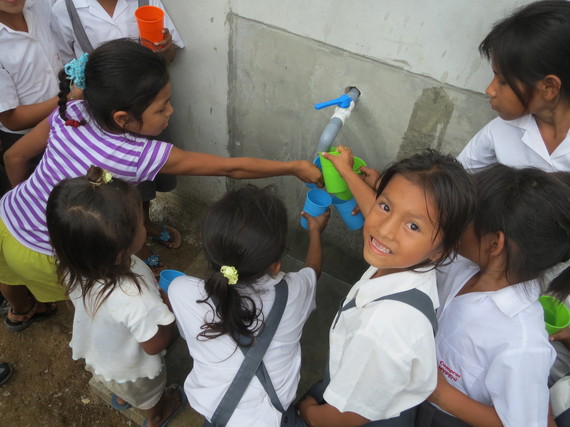On an August day in 2012, in a remote jungle village in Peru, a group of little girls jostled each other for a turn at a newly installed spigot, where they could fill plastic cups for their first-ever drink of filtered water.
One girl made a face as she sipped from her cup. The clear liquid, run through a simple purification system, tasted very different from the polluted Amazon tributary water that village residents were used to drinking.
As I watched the girls' excited faces, I felt a similar incredulity--not about the transformation of river water from muddy to sparkling, but at how the simple desire to help others had brightened and clarified my life.
A few years earlier my husband and I had lost our only son in a car accident. In the aftermath our lives had seemed utterly pointless. Slowly, however, I realized I wanted to honor our son by helping other people in lasting ways. I wanted to find my own form of Seva, a Sanskrit word that means the kind of service in which you lose yourself--and also find yourself.
I set out to examine the differences between the charities that do the best work and those that make only superficial improvements in peoples' lives. My journey took me throughout the U.S., to a poor corner of Mexico and finally to Peru, where the nonprofit group CONAPAC works with residents downstream from the jungle city of Iquitos.
Along the way I learned that my ideas about helping others were completely upside down.
Consider the American psyche. We're the can-do nation, the efficiency experts. We're quite generous--but we're also in a hurry. We like shovel-ready projects. We arrive boots on the ground, identify the problems, solve them, and move on.
This model doesn't work well except in very simple situations, which are increasingly rare. By not taking time to learn about the culture and practices of the people we're trying to help, and by not sticking around to assure long-term results, we set ourselves up for failure, here and abroad.
Problems arise for reasons more varied and nuanced than I ever imagined. A sanitation project in a remote village in India was abandoned because the modest women there didn't want men to know when they used the toilet. A water treatment plant in Benin was mistakenly built on sacred ground, because tribe members never mentioned that the site had special meaning for them. They didn't want to appear ungrateful. The plant was never used.
What does work? The successful recipe is deceptively simple, regardless of the location, culture, or depth of the problems being addressed.
1. We need to abandon all but the loosest idea that we know what to do before we even arrive on the scene. This is essential. Solutions must be forged hand-in-hand with the people who need aid. That's one of the beauties of CONAPAC's water treatment plants, which are built by villagers using local supplies and operated by trained members of the communities.
2. It's vital to talk extensively with the people who need help to discover their most pressing needs. This is not always easy. In many situations, men will dominate all conversations. But it's often the women who know what's most critically needed, especially when it comes to family wellbeing.
3. Look for the strengths within the people receiving aid, and work alongside them. Involve them in every step. And don't forget to cultivate respect for them. This comes in especially handy when they do something utterly unexpected or counter to reason--which happens all the time.
4. Selfless service is never a one-person show. Those of us who truly hope to help others must be flexible, quick to admit mistakes, and willing to let go of even our most cherished ideas and plans for success. This is the best way to build trust between team members.
Sound difficult and possibly tedious? It can be at times. But the most committed practitioners of Seva--those who have honed selfless service to an art form--are among the most peaceful and happy people I've ever met. As Cynthia Smith Snyder, a Michigan woman who spends much of the year managing CONAPAC's service projects in Peru told me, "I never, ever wonder anymore if my life has meaning."
Fortunately, practicing Seva doesn't require a move to the jungle. There are countless opportunities to help people everywhere, everyday.
The first step is simply noticing the need around us and opening our hearts, so that when we dive in to help our efforts bear fruit.
Once these criteria are met, I've found, our American model of ingenuity and generosity works very well indeed.
My grief over losing our son will always be with me. But in searching for Seva I've found a new lightness and sense of purpose. I always hope that my work will help change the lives of others. But I can tell you absolutely that it's changed my own.

